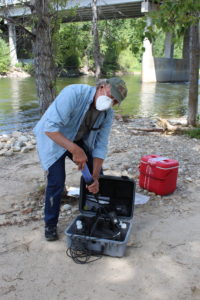
Summertime is here and Bitterroot River Health Check volunteers are headed out into the field to collect water samples and measure water flows in the Bitterroot River watershed once again. The organization was recently awarded two grants to pay for laboratory costs for analyzing water samples from Bitterroot River tributaries along the Sapphire Front on the east side of the valley this year. One of the grants, for $3,362, was from the Montana Department of Environmental Quality’s fund for volunteer water quality laboratory analysis. An additional grant for $3,393 was awarded by the Flathead Lake Biological Station which administers the Monitoring Montana Waters Fund.
The Bitterroot River Health Check program is a non-profit citizen-science based program based at the Bitterroot College and is supported by individuals, businesses and non-profit organizations working with various government agencies to collect water quality and quantity data throughout the valley. Partners include the Bitterroot River Protection Association, Bitterroot Trout Unlimited, Bitterrooters for Planning, Montana Department of Environmental Quality, Montana Department of Natural Resources and Conservation, and the Bitterroot National Forest.
According to Michael Howell, executive director of the Bitterroot River Protection Association, who manages the program, the collective began gathering water quality data using citizen science trained volunteers in 2017. The group began monitoring four sites on the river mainstem under DEQ’s direction in 2017. By 2019, the number of sites had grown to six and DEQ adopted a plan to continue the long-term trend monitoring for 20 years.
Dedicated to establishing a system of long-term monitoring sites throughout the entire watershed, the river health check program was expanded in 2018 to include 11 sites on six tributaries along the Sapphire Front, including sites on Three Mile Creek, North Burnt Fork Creek, Willow Creek, Skalkaho Creek, Rye Creek and North Rye Creek. Two sites have been established on each creek (except North Rye), one near the mouth of the stream where it enters the river and another at the National Forest boundary where it first enters private land.
This year the group has signed a Memorandum of Understanding with the Bitterroot National Forest allowing for the establishment of long-term water quality and flow monitoring sites on tributaries across the Bitterroot Front. According to Howell, the group is already working with a team from the University of Montana, led by Dr. Payton Gardner, that is also interested in collecting flow data especially to determine the quantity and the timing of the spring runoff. Howell said that work was very much in the preliminary stages, but sites on three streams of interest had been identified including sites on Lost Horse Creek, Mill Creek and Bass Creek.
“It’s all very exciting,” said Howell. “If you had asked me how our long-term monitoring plans were proceeding a couple of years ago I would have said it was growing like a snowball rolling down a mountain. This year I’d say it’s a more like surfing on an avalanche. “
Howell said the program on the river mainstem is well established and running like clockwork. Kent Myers, a retired scientist from GSK and member of the Bitterroot Conservation District Board of Supervisors, leads the sampling from Bell Crossing to Buckhouse Bridge. Kelsey Milner, a retired forester, leads the team sampling on the south mainstem from south of Darby through Hamilton. Howell said that he manages the tributary project on the Sapphire Front by working closely with local landowners who live along the creeks being sampled.
“The work up along the Bitterroot Front will probably be organized a little differently,” he said. “We will probably have a special team willing to hike to the wilderness boundary on these creeks.” He said the wilderness boundary sites are not only more arduous to get to but also involve a little more risk. He said they carry a special GPS device with SOS capabilities that can communicate with 911 in case of emergency.
Howell said that community support for the river health check program has been tremendous as well as the encouragement and help offered by government agencies.
“The fact that DEQ recognized the value of having a citizen-science trained volunteer work force in the Bitterroot and put us to work was great,” said Howell. “But the fact that they decided they could depend on us enough to establish a 20-year long-term monitoring plan for the Bitterroot mainstem and commit themselves to it makes us very proud.”
“What we really want to crow about now, however, is that DEQ and the Flathead Lake Biological Station have both awarded us separate grants which will cover the cost of the laboratory analysis of our samples on the tributaries in the Sapphire Front project this year,” said Howell.
Howell said that the community as a whole has also been very generous. He said the group recently received a grant from the Rapp Family Foundation that was used to purchase a laboratory scale to be used in their budding algae monitoring program. The scale will be installed at the science laboratory at the Bitterroot College, and it will also be used in classroom teaching.“The Bitterroot River Health Check program is well on its way to realizing its dream of a systematic, network of long term water quality monitoring and flow measurement sites across the entire Bitterroot Watershed,” said Howell. He said that the group’s signature fund raising event, a music festival at the river, has been scuttled by Covid-19 so the group is struggling to convert to online funding efforts. He said anyone interested in donating to the effort can do so online by going to www.bitterrootriver.org. For more information call Michael Howell at 239-4838 or email bitterrootriverprotection@gmail.com.